Can You Take Rocks From Jasper Beach Maine? The answer is generally no, but let’s dive deeper into the reasons why and explore the unique beauty of this coastal gem with rockscapes.net. This article will cover the rules, the geological significance, and alternative ways to enjoy the stunning rock formations.
1. What Are the Regulations Regarding Rock Removal at Jasper Beach?
It’s important to know the rules. Taking rocks from Jasper Beach, Maine is generally prohibited to preserve its unique geological features and protect the natural environment, as removing these stones can disrupt the beach’s ecosystem and diminish its distinctive character.
Understanding the Laws
Laws surrounding the removal of natural materials from beaches vary depending on the location. Jasper Beach is subject to specific regulations that aim to protect its geological integrity. These regulations are in place to ensure the beach remains a stunning natural landmark for generations to come.
- Local Ordinances: Machiasport, Maine, where Jasper Beach is located, has local ordinances that prohibit the removal of rocks and other natural materials from the beach. These ordinances are enforced to maintain the beach’s unique character and ecological balance.
- State Regulations: Maine also has state-level regulations that protect coastal resources. These regulations may overlap with local ordinances to provide comprehensive protection for beaches like Jasper Beach.
- Federal Regulations: While federal regulations might not directly address rock removal from beaches, they often cover broader environmental protections that indirectly support local and state efforts.
Why Are These Regulations in Place?
The regulations against rock removal are in place for several important reasons:
- Preservation of Geological Features: Jasper Beach is renowned for its unique collection of jasper and rhyolite pebbles. Removing these stones diminishes the beach’s distinctive geological character, which is a significant draw for tourists and researchers alike.
- Ecosystem Protection: Beaches are delicate ecosystems that support a variety of plant and animal life. Removing rocks can disrupt these ecosystems, affecting the habitats of various species.
- Erosion Control: Rocks play a crucial role in preventing beach erosion. Their presence helps to absorb wave energy and stabilize the shoreline. Removing them can increase the risk of erosion, leading to the loss of valuable coastal land.
- Maintaining Aesthetic Value: The aesthetic appeal of Jasper Beach is a major attraction for visitors. The beach’s beauty is largely due to its unique composition of colorful stones. Removing these stones detracts from the beach’s overall aesthetic value.
Consequences of Violating the Regulations
Violating the regulations against rock removal can result in significant penalties. These penalties can vary depending on the severity of the offense and the specific regulations in place.
- Fines: Individuals caught removing rocks from Jasper Beach may face substantial fines. The amount of the fine can vary depending on the quantity of rocks removed and the specific regulations violated.
- Legal Action: In some cases, repeat offenders or those who remove large quantities of rocks may face legal action. This could result in criminal charges and further penalties.
- Community Service: As an alternative to or in addition to fines, violators may be required to perform community service. This could involve assisting with beach cleanup or other conservation efforts.
Alternative Ways to Enjoy Jasper Beach
While you can’t take rocks from Jasper Beach, there are plenty of other ways to enjoy its beauty and unique geological features.
- Photography: Capture the stunning colors and patterns of the beach’s stones through photography. This allows you to preserve your memories of Jasper Beach without harming its environment.
- Rock Balancing: Engage in the meditative practice of rock balancing. This involves carefully stacking stones to create temporary sculptures. Be sure to dismantle your creations before leaving to avoid disrupting the natural environment.
- Beachcombing (Observational): Explore the beach and observe the various types of rocks and marine life. Take note of the different colors, shapes, and textures of the stones, and learn about the geological processes that have shaped them.
- Educational Tours: Participate in guided tours led by local experts. These tours provide valuable insights into the geology, ecology, and history of Jasper Beach.
Supporting Conservation Efforts
If you’re passionate about protecting Jasper Beach and other natural areas, consider supporting conservation efforts.
- Volunteer: Volunteer your time to assist with beach cleanups or other conservation projects. This is a great way to give back to the community and help preserve the natural environment.
- Donate: Donate to local conservation organizations that work to protect Jasper Beach and other coastal areas. Your financial support can help fund important research, education, and conservation initiatives.
- Educate Others: Spread awareness about the importance of protecting natural resources. Encourage others to respect the environment and follow regulations designed to preserve it for future generations.
Visiting Jasper Beach offers a unique opportunity to connect with nature and appreciate the beauty of the Maine coast. By respecting the regulations and supporting conservation efforts, you can help ensure that this stunning natural landmark remains a treasure for years to come.
2. What Makes Jasper Beach’s Rocks So Special and Unique?
Jasper Beach’s rocks are unique due to their composition, smooth texture, and vibrant colors. These characteristics are a result of the region’s geological history and ongoing wave action. Let’s explore what makes Jasper Beach rocks so unique.
Geological Composition of Jasper Beach Rocks
The rocks at Jasper Beach are primarily composed of jasper and rhyolite, both of which are rich in iron. This high iron content gives the rocks their distinctive reddish hue, which is particularly prominent when the stones are wet.
- Jasper: Jasper is a form of chalcedony, a microcrystalline variety of quartz. It is known for its smooth texture and vibrant colors, which range from deep red to yellowish-brown. The iron oxides within jasper are responsible for its characteristic coloration.
- Rhyolite: Rhyolite is a fine-grained volcanic rock that is chemically similar to granite but has a much smaller crystal size. Like jasper, rhyolite is often rich in iron, which contributes to its reddish color. The rhyolite at Jasper Beach has been smoothed by wave action over many years, giving it a polished appearance.
- Other Minerals: In addition to jasper and rhyolite, the rocks at Jasper Beach may also contain other minerals such as quartz, agate, and various forms of silica. These minerals add to the diversity of colors and patterns found on the beach.
The Smoothing Process
One of the most distinctive features of Jasper Beach rocks is their smooth, rounded texture. This is the result of a natural smoothing process that occurs over many years as the stones are tumbled and polished by the waves.
- Wave Action: The constant motion of the waves against the rocks causes them to rub against each other, gradually wearing away any sharp edges or rough surfaces. This process is particularly effective at Jasper Beach due to the beach’s exposed location and the strong tidal currents in the area.
- Abrasion: As the rocks are tumbled by the waves, they also undergo abrasion from sand and other small particles. This abrasion further smooths the surfaces of the stones, giving them a polished appearance.
- Time: The smoothing process takes a considerable amount of time, with each rock undergoing countless cycles of tumbling and abrasion over many years. The result is a collection of stones that are remarkably smooth and tactile.
Colors and Patterns of Jasper Beach Rocks
The rocks at Jasper Beach come in a wide range of colors and patterns, making each stone unique. These variations are due to differences in the mineral composition of the rocks, as well as the effects of weathering and erosion.
- Red Hues: The dominant color at Jasper Beach is red, due to the high iron content of the jasper and rhyolite. However, the intensity of the red color can vary depending on the specific composition of the rock and the amount of iron present.
- Other Colors: In addition to red, the rocks at Jasper Beach may also exhibit other colors such as white, gray, brown, and even green. These variations are due to the presence of other minerals such as quartz, agate, and chlorite.
- Patterns: Many of the rocks at Jasper Beach feature unique patterns and markings, such as bands, swirls, and spots. These patterns are the result of geological processes that occurred during the formation of the rocks, as well as the effects of weathering and erosion over time.
Geological History of the Region
The unique characteristics of Jasper Beach rocks are closely tied to the geological history of the region. The rocks themselves were formed millions of years ago through volcanic activity and sedimentary processes.
- Volcanic Activity: The rhyolite rocks at Jasper Beach are the result of ancient volcanic eruptions that occurred in the region millions of years ago. These eruptions deposited layers of volcanic ash and lava, which eventually solidified into rhyolite.
- Sedimentary Processes: The jasper rocks at Jasper Beach were formed through sedimentary processes, in which minerals dissolved in water precipitated out to form solid rock. These processes occurred over millions of years, resulting in the formation of the jasper deposits that are found at Jasper Beach today.
- Glacial Activity: During the Ice Age, the region around Jasper Beach was covered by glaciers. These glaciers played a role in shaping the landscape and depositing rocks and sediments in the area.
Why You Should Visit
Visiting Jasper Beach offers a unique opportunity to witness the beauty of nature and learn about the geological processes that have shaped our planet. The beach’s unique collection of smooth, colorful stones is a testament to the power of time and the forces of nature.
- Scenic Beauty: Jasper Beach is renowned for its scenic beauty, with its colorful stones, rugged coastline, and stunning ocean views. A visit to Jasper Beach is a feast for the senses and a chance to connect with the natural world.
- Educational Opportunity: Jasper Beach offers a unique opportunity to learn about geology and earth science. The beach’s rocks provide a tangible example of the processes that have shaped our planet over millions of years.
- Recreational Activities: In addition to its scenic beauty and educational value, Jasper Beach also offers a variety of recreational activities such as hiking, birdwatching, and photography.
In conclusion, the rocks at Jasper Beach are special and unique due to their geological composition, the smoothing process they have undergone, and the wide range of colors and patterns they exhibit. A visit to Jasper Beach is a chance to witness the beauty of nature and learn about the geological history of the region.
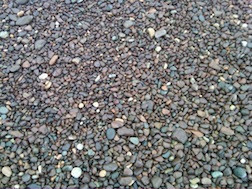 Jasper Beach stones with reddish hue
Jasper Beach stones with reddish hue
3. What Are Some Alternative Beaches for Rock Collecting in Maine?
While taking rocks from Jasper Beach is prohibited, Maine offers several alternative beaches where rock collecting is permitted, allowing you to enjoy the thrill of finding unique stones without harming protected areas.
Popham Beach State Park
Popham Beach State Park, located in Phippsburg, is renowned for its expansive sandy beach and dynamic coastal environment. This park allows visitors to collect rocks, with certain restrictions in place to protect the natural landscape.
- Location and Accessibility: Popham Beach State Park is easily accessible by car and offers ample parking. The park is open year-round, but services may be limited during the off-season.
- Rock Collecting Opportunities: The beach is rich in a variety of rocks, including granite, quartz, and metamorphic rocks. These stones are typically found along the high tide line and near the mouth of the Morse River.
- Regulations and Guidelines: While rock collecting is allowed, it is important to adhere to the park’s regulations. Avoid collecting large quantities of rocks and refrain from digging or disturbing the natural vegetation.
Ogunquit Beach
Ogunquit Beach, known for its long sandy stretch and scenic beauty, is another great location for rock collecting. Situated in the charming town of Ogunquit, this beach provides a delightful setting for both relaxation and exploration.
- Location and Accessibility: Ogunquit Beach is easily accessible from Route 1 and offers several parking areas. The beach is a popular destination, so arriving early is advisable, especially during the summer months.
- Rock Collecting Opportunities: The southern end of Ogunquit Beach, near the Marginal Way, is particularly fruitful for rock collectors. Here, you can find a mix of sedimentary and igneous rocks, often adorned with interesting patterns and textures.
- Regulations and Guidelines: As with other beaches, it’s essential to follow local guidelines when collecting rocks. Take only what you need and avoid disturbing the natural habitat.
Reid State Park
Reid State Park, located in Georgetown, features diverse landscapes, including sandy beaches, rocky cliffs, and salt marshes. This park offers a range of environments suitable for different types of rock collecting.
- Location and Accessibility: Reid State Park is located at the end of Seguinland Road in Georgetown. The park is open year-round and charges a day-use fee during the summer months.
- Rock Collecting Opportunities: Mile Beach and Griffith Head offer excellent opportunities for finding unique rocks. The park’s varied geology means you can discover a wide assortment of stones, from smooth beach pebbles to more rugged specimens.
- Regulations and Guidelines: Be mindful of the park’s regulations regarding rock collecting. Collecting small quantities for personal use is generally acceptable, but avoid commercial harvesting or disturbing sensitive areas.
Sand Beach in Acadia National Park
Sand Beach, nestled within Acadia National Park, is a unique coastal gem known for its small size and stunning scenery. While the focus here is on the beach itself, rock collecting is permitted in certain areas.
- Location and Accessibility: Sand Beach is located off Park Loop Road in Acadia National Park. A park entrance fee is required, and parking can be limited, especially during peak season.
- Rock Collecting Opportunities: The rocky areas surrounding Sand Beach offer a chance to find interesting stones. Look for rocks with unique geological features and vibrant colors.
- Regulations and Guidelines: Acadia National Park has strict regulations to protect its natural resources. Be sure to check the specific guidelines for rock collecting and avoid removing any rocks from protected areas.
Tips for Responsible Rock Collecting
Regardless of which beach you choose, responsible rock collecting is essential to preserving these natural environments for future generations.
- Know the Regulations: Always check local regulations and guidelines before collecting rocks. This information is often available on park websites or from local authorities.
- Take Only What You Need: Collect only a small amount of rocks for personal use. Over-collecting can deplete the natural resources of a beach and harm its ecosystem.
- Avoid Disturbing Habitats: Be careful not to disturb or damage plant or animal habitats while collecting rocks. Stay on established trails and avoid trampling vegetation.
- Leave No Trace: Pack out everything you pack in, including any trash or debris. Leave the beach as you found it, so others can enjoy its natural beauty.
- Respect Private Property: Be aware of property boundaries and respect private property rights. Do not collect rocks from areas that are clearly marked as private.
By following these tips, you can enjoy rock collecting while helping to protect Maine’s beautiful beaches and coastal environments.
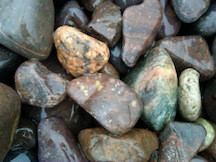 Stones on the beach
Stones on the beach
4. How Does Removing Rocks Impact Coastal Erosion?
Removing rocks can significantly impact coastal erosion by weakening natural defenses and disrupting sediment balance, leading to increased vulnerability to storms and rising sea levels.
The Role of Rocks in Coastal Protection
Rocks play a crucial role in protecting coastlines from erosion. They act as natural barriers that absorb wave energy, reduce the impact of storms, and stabilize the shoreline.
- Wave Energy Absorption: Rocks dissipate the energy of incoming waves, reducing their erosive force. This is particularly important during storms, when high waves can cause significant damage to coastal areas.
- Sediment Stabilization: Rocks help to anchor sediment in place, preventing it from being washed away by waves and currents. This is essential for maintaining the stability of beaches and other coastal landforms.
- Storm Surge Protection: Rocks can act as a buffer against storm surges, reducing the extent to which floodwaters penetrate inland. This can help to protect coastal communities from the devastating effects of storms.
Impact of Rock Removal
Removing rocks from coastal areas can have several negative impacts on coastal erosion:
- Reduced Wave Energy Absorption: When rocks are removed, the coastline becomes more exposed to the full force of incoming waves. This can lead to increased erosion, particularly during storms.
- Sediment Loss: Rocks help to trap sediment on beaches and in coastal areas. When they are removed, sediment is more easily washed away, leading to beach loss and coastal retreat.
- Habitat Destruction: Rocks provide habitat for a variety of marine organisms, including algae, barnacles, and shellfish. Removing rocks can destroy these habitats, disrupting the local ecosystem and reducing biodiversity.
- Increased Vulnerability to Storms: Coastlines that have had rocks removed are more vulnerable to the impacts of storms. They are more likely to experience flooding, erosion, and damage to infrastructure.
Examples of Coastal Erosion Due to Rock Removal
Several real-world examples demonstrate the negative impacts of rock removal on coastal erosion:
- Coastal Development in Florida: In some areas of Florida, coastal development has involved the removal of natural rock formations to create sandy beaches. This has led to increased erosion and the need for costly beach renourishment projects.
- Mining Activities in Coastal Areas: Mining activities in coastal areas can involve the removal of large quantities of rock, leading to significant erosion and habitat destruction.
- Illegal Rock Collection: In many coastal areas, illegal rock collection is a problem. Even small-scale rock removal can have a cumulative impact on coastal erosion over time.
Mitigation Strategies
Several strategies can be used to mitigate the negative impacts of rock removal on coastal erosion:
- Regulations and Enforcement: Implementing and enforcing regulations that prohibit or restrict rock removal is essential for protecting coastal areas.
- Beach Renourishment: Beach renourishment involves adding sand to eroded beaches to restore their natural width. This can help to protect coastal areas from further erosion.
- Coastal Engineering: Coastal engineering projects, such as the construction of seawalls and groins, can help to protect coastlines from erosion. However, these projects can be expensive and may have negative impacts on the environment.
- Public Education: Educating the public about the importance of protecting coastal areas is essential for promoting responsible behavior and reducing the incidence of rock removal.
The Role of Rockscapes.net
Rockscapes.net plays a crucial role in promoting responsible coastal management by providing information and resources on the importance of protecting coastal areas.
- Educational Resources: Rockscapes.net offers a variety of educational resources on coastal erosion, including articles, videos, and interactive maps.
- Advocacy: Rockscapes.net advocates for policies that protect coastal areas and promote sustainable coastal management practices.
- Community Engagement: Rockscapes.net engages with local communities to raise awareness about coastal erosion and encourage responsible behavior.
By providing information, advocating for policies, and engaging with communities, rockscapes.net helps to protect coastal areas from the negative impacts of rock removal and other threats.
5. What Types of Rocks Can You Find at Jasper Beach?
At Jasper Beach, you can primarily find jasper and rhyolite rocks, known for their reddish hues, along with occasional quartz and other mineral variations, each contributing to the beach’s unique and colorful appearance.
Jasper Rocks
Jasper is a form of chalcedony, which is a microcrystalline variety of quartz. It is characterized by its smooth texture and rich colors, often ranging from deep red to yellowish-brown. The red color in jasper is primarily due to the presence of iron oxides.
- Formation: Jasper forms in sedimentary or volcanic environments where silica-rich fluids percolate through rocks. As the fluids cool and evaporate, they deposit silica, along with other minerals like iron oxides, which give jasper its distinctive color.
- Characteristics: Jasper rocks are typically hard and durable, with a smooth, polished surface. They often exhibit patterns and variations in color, making each stone unique.
- Identification: To identify jasper, look for rocks with a reddish-brown color and a smooth, waxy luster. Jasper is also relatively dense and does not easily scratch.
Rhyolite Rocks
Rhyolite is a fine-grained volcanic rock that is chemically similar to granite but has a much smaller crystal size. Like jasper, rhyolite is often rich in iron, which contributes to its reddish color.
- Formation: Rhyolite forms from the rapid cooling of silica-rich lava. The rapid cooling prevents the formation of large crystals, resulting in a fine-grained texture.
- Characteristics: Rhyolite rocks are typically light to medium in color, often with shades of red, pink, or gray. They may also contain small crystals of quartz or feldspar, which are visible under magnification.
- Identification: To identify rhyolite, look for rocks with a fine-grained texture and a light to medium color. Rhyolite is also relatively hard and does not easily scratch.
Quartz Rocks
Quartz is one of the most abundant minerals on Earth, and it can be found in a variety of forms at Jasper Beach. Quartz rocks are typically clear or white in color, but they may also be tinted with other minerals.
- Formation: Quartz forms in a variety of geological environments, including igneous, metamorphic, and sedimentary rocks. It is highly resistant to weathering and erosion, which is why it is often found in beach environments.
- Characteristics: Quartz rocks are typically hard and durable, with a glassy luster. They may be clear, white, or tinted with other colors.
- Identification: To identify quartz, look for rocks with a glassy luster and a hardness of 7 on the Mohs scale. Quartz will scratch glass and is not easily scratched by other minerals.
Other Mineral Variations
In addition to jasper, rhyolite, and quartz, Jasper Beach may also contain other mineral variations, such as agate, chalcedony, and various forms of silica.
- Agate: Agate is a form of chalcedony that is characterized by its banded patterns. These patterns are formed by the deposition of silica in layers, often with varying colors and textures.
- Chalcedony: Chalcedony is a microcrystalline variety of quartz that is similar to jasper but is typically lighter in color. It may be white, gray, or bluish in color.
- Silica: Silica is a chemical compound composed of silicon and oxygen. It is the main component of many rocks and minerals, including quartz, jasper, and chalcedony.
Identifying Rocks at Jasper Beach
Identifying rocks at Jasper Beach can be a fun and educational activity. Here are some tips to help you identify the different types of rocks:
- Color: Pay attention to the color of the rock. Jasper is typically reddish-brown, while rhyolite is often light to medium in color. Quartz is usually clear or white.
- Texture: Examine the texture of the rock. Jasper is smooth and waxy, while rhyolite is fine-grained. Quartz is glassy.
- Hardness: Test the hardness of the rock. Quartz is very hard and will scratch glass. Jasper and rhyolite are also relatively hard.
- Patterns: Look for patterns or variations in color. Agate is characterized by its banded patterns.
Why You Should Learn
Learning about the different types of rocks at Jasper Beach can enhance your appreciation for the natural world and provide you with a deeper understanding of the geological processes that have shaped our planet.
- Educational Value: Identifying rocks can be a fun and educational activity for people of all ages.
- Appreciation for Nature: Learning about the different types of rocks can deepen your appreciation for the beauty and complexity of nature.
- Connection to Geology: Identifying rocks can connect you to the field of geology and provide you with a greater understanding of Earth’s history.
In conclusion, Jasper Beach offers a unique opportunity to explore a variety of rocks and minerals, each with its own distinctive characteristics. By learning about the different types of rocks at Jasper Beach, you can enhance your appreciation for the natural world and gain a deeper understanding of the geological processes that have shaped our planet.
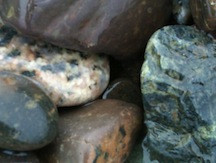 Orange quartz showing chips of white and black
Orange quartz showing chips of white and black
6. What Is the Significance of Jasper Beach to the Local Ecosystem?
Jasper Beach is significant to the local ecosystem as it provides habitat for marine life, supports unique plant communities, and contributes to coastal resilience, making its preservation crucial for maintaining biodiversity and ecological balance.
Habitat for Marine Life
Jasper Beach provides habitat for a variety of marine organisms, including algae, barnacles, shellfish, and fish.
- Algae and Seaweed: The rocks at Jasper Beach provide a substrate for algae and seaweed to attach to. These plants are a primary food source for many marine animals.
- Barnacles and Shellfish: Barnacles and shellfish attach to the rocks at Jasper Beach, providing shelter and food for other marine organisms.
- Fish: Fish use the rocks at Jasper Beach as a refuge from predators and as a spawning ground.
Support for Unique Plant Communities
Jasper Beach supports unique plant communities that are adapted to the harsh coastal environment.
- Beach Grass: Beach grass grows along the top of the beach ridge, helping to stabilize the sand and prevent erosion.
- Wild Roses: Wild roses grow along the top of the beach ridge, providing habitat for pollinators and other insects.
- Beach Peas: Beach peas are a common plant at Jasper Beach, helping to fix nitrogen in the soil and providing food for wildlife.
Contribution to Coastal Resilience
Jasper Beach contributes to coastal resilience by providing a natural barrier against storms and erosion.
- Wave Energy Absorption: The rocks at Jasper Beach absorb wave energy, reducing the impact of storms on the coastline.
- Sediment Stabilization: The rocks at Jasper Beach help to stabilize sediment, preventing erosion and maintaining the integrity of the coastline.
- Storm Surge Protection: The rocks at Jasper Beach provide a buffer against storm surges, reducing the extent to which floodwaters penetrate inland.
Threats to the Ecosystem
Several threats to the ecosystem at Jasper Beach include:
- Rock Removal: Removing rocks from Jasper Beach can disrupt the ecosystem, leading to habitat loss and increased erosion.
- Pollution: Pollution from nearby sources can harm marine life and plant communities at Jasper Beach.
- Climate Change: Climate change is leading to rising sea levels, which can inundate coastal areas and alter the ecosystem at Jasper Beach.
Conservation Efforts
Several conservation efforts are underway to protect the ecosystem at Jasper Beach:
- Regulations and Enforcement: Regulations are in place to protect Jasper Beach from rock removal and other harmful activities. These regulations are enforced by local authorities.
- Beach Cleanups: Beach cleanups are organized to remove trash and debris from Jasper Beach, helping to protect marine life and plant communities.
- Habitat Restoration: Habitat restoration projects are underway to restore damaged areas of Jasper Beach, such as eroded sand dunes.
How You Can Help
There are several ways you can help protect the ecosystem at Jasper Beach:
- Follow Regulations: Follow all regulations designed to protect Jasper Beach, such as those prohibiting rock removal.
- Participate in Beach Cleanups: Participate in beach cleanups to remove trash and debris from Jasper Beach.
- Reduce Pollution: Reduce pollution by properly disposing of waste and avoiding the use of harmful chemicals.
- Support Conservation Organizations: Support conservation organizations that work to protect Jasper Beach and other coastal areas.
By taking these steps, you can help ensure that Jasper Beach remains a healthy and vibrant ecosystem for future generations.
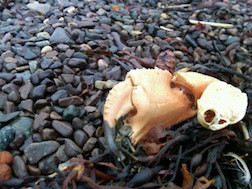 Crab claw on Jasper Beach
Crab claw on Jasper Beach
7. Are There Any Guided Tours of Jasper Beach Available?
Yes, there are guided tours of Jasper Beach available, offering valuable insights into the geology, ecology, and history of this unique coastal environment, enhancing your appreciation and understanding.
Benefits of Guided Tours
Guided tours offer several benefits for visitors to Jasper Beach:
- Expert Knowledge: Guided tours are led by knowledgeable experts who can provide insights into the geology, ecology, and history of Jasper Beach.
- Enhanced Appreciation: Guided tours can enhance your appreciation for the unique features of Jasper Beach, such as its colorful stones and diverse marine life.
- Safety: Guided tours can help you stay safe while exploring Jasper Beach, by providing information about potential hazards and precautions to take.
- Conservation: Guided tours can promote conservation by educating visitors about the importance of protecting Jasper Beach and its ecosystem.
Types of Guided Tours
Several types of guided tours are available at Jasper Beach:
- Geological Tours: Geological tours focus on the geology of Jasper Beach, including the formation of its rocks and the geological processes that have shaped the coastline.
- Ecological Tours: Ecological tours focus on the ecology of Jasper Beach, including its marine life, plant communities, and coastal ecosystem.
- Historical Tours: Historical tours focus on the history of Jasper Beach, including its Native American heritage and its role in the local economy.
- Combination Tours: Combination tours combine elements of geological, ecological, and historical tours, providing a comprehensive overview of Jasper Beach.
Finding Guided Tours
You can find guided tours of Jasper Beach through several sources:
- Local Tourism Agencies: Local tourism agencies, such as the Machias Area Chamber of Commerce, can provide information about guided tours of Jasper Beach.
- Parks and Recreation Departments: Parks and recreation departments, such as the Machiasport Parks and Recreation Department, may offer guided tours of Jasper Beach.
- Environmental Organizations: Environmental organizations, such as the Maine Coast Heritage Trust, may offer guided tours of Jasper Beach as part of their educational programs.
- Online Search: You can search online for guided tours of Jasper Beach using search engines like Google or Bing.
What to Expect on a Guided Tour
On a guided tour of Jasper Beach, you can expect to:
- Meet Your Guide: You will meet your guide at a designated meeting point, such as the Jasper Beach parking area.
- Receive an Introduction: Your guide will provide an introduction to Jasper Beach, including its history, geology, and ecology.
- Explore the Beach: You will explore the beach with your guide, learning about the different types of rocks, marine life, and plant communities.
- Ask Questions: You will have the opportunity to ask questions and learn more about Jasper Beach.
- Learn About Conservation: Your guide will discuss the importance of conservation and how you can help protect Jasper Beach.
Tips for a Successful Tour
Here are some tips for having a successful guided tour of Jasper Beach:
- Dress Appropriately: Dress appropriately for the weather, including wearing comfortable shoes and bringing rain gear if necessary.
- Bring Water and Snacks: Bring water and snacks to stay hydrated and energized during the tour.
- Wear Sunscreen: Wear sunscreen to protect your skin from the sun.
- Bring a Camera: Bring a camera to capture the beauty of Jasper Beach.
- Ask Questions: Don’t be afraid to ask questions and engage with your guide.
- Respect the Environment: Respect the environment by following your guide’s instructions and avoiding harmful activities.
The Value of Exploration
Visiting Jasper Beach and taking a guided tour can provide a valuable opportunity to connect with nature, learn about science, and promote conservation.
- Connection to Nature: Spending time at Jasper Beach can help you connect with nature and appreciate the beauty of the natural world.
- Scientific Learning: Learning about the geology, ecology, and history of Jasper Beach can enhance your understanding of science and the environment.
- Conservation Promotion: Supporting guided tours and other conservation efforts can help protect Jasper Beach for future generations.
In conclusion, guided tours of Jasper Beach offer a unique opportunity to learn about this special place and promote its conservation. By taking a guided tour, you can enhance your appreciation for nature, expand your scientific knowledge, and contribute to the protection of our planet.
8. What Amenities Are Available for Visitors at Jasper Beach?
Jasper Beach offers limited but essential amenities for visitors, including parking, restrooms, and informational signage, ensuring a comfortable and informative experience while preserving the natural beauty of the area.
Parking Facilities
Parking is available at Jasper Beach, but it is limited. It’s important to arrive early, especially during peak season, to secure a parking spot.
- Location: The parking area is located near the entrance to the beach, providing easy access to the shoreline.
- Capacity: The parking area can accommodate a limited number of vehicles. During busy times, it may be necessary to park along the road.
- Accessibility: The parking area is generally accessible, but it may be uneven in some areas.
Restroom Facilities
Restroom facilities are available at Jasper Beach, providing a convenient amenity for visitors.
- Location: The restrooms are located near the parking area, making them easily accessible.
- Type: The restrooms are typically basic, but they are generally clean and well-maintained.
- Accessibility: The restrooms are generally accessible, but they may not be fully ADA compliant.
Informational Signage
Informational signage is available at Jasper Beach, providing visitors with information about the beach’s geology, ecology, and history.
- Location: The signage is located at various points along the beach, providing information about different features of the area.
- Content: The signage provides information about the types of rocks found at Jasper Beach, the marine life that inhabits the area, and the history of the local community.
- Purpose: The signage is designed to educate visitors about Jasper Beach and promote conservation.
Other Amenities
In addition to parking, restrooms, and informational signage, Jasper Beach may also offer other amenities, such as:
- Picnic Areas: Picnic areas may be available at Jasper Beach, providing a place for visitors to enjoy a meal or snack.
- Walking Trails: Walking trails may be available at Jasper Beach, allowing visitors to explore the area and enjoy the scenery.
- Lifeguards: Lifeguards may be on duty during peak season, providing safety for swimmers and beachgoers.
Nearby Amenities
If Jasper Beach does not offer all the amenities you need, you may be able to find them in nearby towns, such as Machiasport.
- Restaurants: Restaurants are available in Machiasport, offering a variety of dining options.
- Lodging: Lodging is available in Machiasport, ranging from hotels to bed and breakfasts.
- Shopping: Shopping is available in Machiasport, including grocery stores, souvenir shops, and art galleries.
Planning Your Visit
To make the most of your visit to Jasper Beach, it’s important to plan ahead and be prepared.
- Check the Weather: Check the weather forecast before you go and dress appropriately.
- Arrive Early: Arrive early to secure a parking spot and avoid crowds.
- Bring Supplies: Bring water, snacks, sunscreen, and other supplies you may need.
- Follow Regulations: Follow all regulations designed to protect Jasper Beach, such as those prohibiting rock removal.
- Respect the Environment: Respect the environment by properly disposing of waste and avoiding harmful activities.
The Value of Preparation
Visiting Jasper Beach and being prepared can provide a valuable opportunity to connect with nature, learn about science, and promote conservation.
- Connection to Nature: Spending time at Jasper Beach can help you connect with nature and appreciate the beauty of the natural world.
- Scientific Learning: Learning about the geology, ecology, and history of Jasper Beach can enhance your understanding of science and the environment.
- Conservation Promotion: Supporting conservation efforts and following regulations can help protect Jasper Beach for future generations.
In conclusion, Jasper Beach offers limited but essential amenities for visitors, ensuring a comfortable and informative experience. By planning ahead, being prepared, and respecting the environment, you can make the most of your visit to this unique coastal gem.
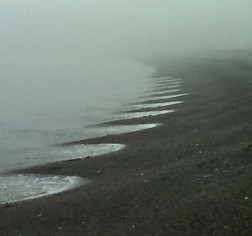 Scalloped Shoreline
Scalloped Shoreline
9. What Kind of Wildlife Can You Observe at Jasper Beach?
At Jasper Beach, you can observe a variety of wildlife, including harbor seals, seabirds like cormorants, and various intertidal creatures such as rock crabs, adding to the rich biodiversity of this coastal habitat.
Seabirds
Seabirds are a common sight at Jasper Beach, as they forage for food in the coastal waters and nest on the nearby cliffs and islands.
- Cormorants: Cormorants are large, black seabirds that are often seen perched on rocks or flying along the coastline. They are skilled divers and feed on fish and other marine creatures.
- Gulls: Gulls are common seabirds that are found in a variety of habitats, including beaches, harbors, and

